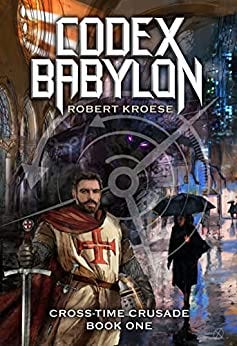It’s the year 2023 (okay, you know that—I mean in the story) and a demonic cabal threatens to topple civilization (still talking about the book—I think I’m still talking about the story). Humanity’s best chance of weathering the coming storm is the Codex Babylon, a book of demonology, and the only place it can be found is sometime around the 12th century. And I know that’s a time, which is not a location, but getting there requires travel too. The first man to go back in time disappeared, and time in the present is running out. An unscrupulous and unconvinced lawyer has the psychic abilities to make a second trip to the past, but when it comes to knowledge and skill he’s woefully unequipped.
The Story
Global Risk Assessment and Insurance, Limited (aka: GRAIL), an off-shoot of the Templars, has worked for centuries to protect the world from demonic forces. Unfortunately, thanks to the increasing power of technology, the demons are gaining the upper hand. GRAIL’s only potential resource to survive a second dark age is the Codex Babylon, possibly Solomon’s notebook for dealing with demons, which hasn’t been seen since the Crusades.
Several years ago GRAIL sent a brilliant scholar, Benedict, back in time to search for the book, with his wife Gabrielle serving as a telepathic tether. Unfortunately, after a few years Benedict’s communications became erratic before stopping completely. Now GRAIL thinks they’ve found a new man with the right set of abilities and gifts to go back and try again. The only problem is Martin doesn’t believe in any of this and resents their attempts to draw him in.
The story moves back and forth between past and present, first as we observe Benedict on his quest, and then the present as GRAIL works to manipulate, persuade, and finally prepare Martin for his trip to the past. In part two Martin is in the past, while Gabrielle and GRAIL search for the Codex in the present. At both ends, it becomes apparent that there’s a traitor inside GRAIL and there’s growing concern as to how much damage he’s done when no one was looking.
Anyone familiar with Templar conspiracies will be right at home. Kroese doesn’t try to overexplain or overcomplicate his time travel. It just is. The main focus in the first book of the trilogy is establishing the stakes and throwing every possible complication in the way. There are hints of Kroese’s trademark humor (“All the demons I know are in middle management”), and twists, turns, and setbacks aplenty. Basically, everything you could want in a novel like this.
The Characters
Benedict (aka: Cormac) is introduced as a priest in the middle ages. He was one of GRAIL’s best and brightest, but searching for the Codex takes a massive mental and physical tole. When he stops communicating with his wife Gabrielle in the present, GRAIL identifies Martin as a replacement. But he’s a family man, who is reluctant to accept the idea of demons, much less work against time and travel it. Gabrielle understandably has some resentment for GRAIL, though she still believes in the mission and agrees to be Martin’s connection to the present.
GRAIL is headed by Ian (who I couldn’t help but imagine as Ian Holm), who may be the most forthright person on the payroll.
In the past we meet various historical and imaginary characters, including Pepin, a young man with a secret sin from which he hopes to find absolution through holy war. He becomes Martin’s squire and guide through the unfamiliar world. Meanwhile, Gabrielle and Paulo (Martin’s first GRAIL contact) travel to Egypt in hopes of finding the Codex in present day, and instead only find more trouble. I actually liked the present day chapters as much or more than those in the past and look forward to spending more time with Gabrielle and Paulo in the sequels.
The World
There’s no forward time travel here, so it’s either 12th century Europe and the Middle East, or the present.
The Politics
None
Content Warning
A few bad words and some PG-13 violence. No ceramic baboons were harmed in the making of this novel [citation needed].
Who is it for?
Imagine if Michael Crichton’s Timeline and Dan Brown’s The Da Vinci Code had a baby. If that sounds like an attractive offspring, this is the book for you.
Why read it?
Robert Kroese fans rejoice! We have new stories. Here he gives us conspiracy, adventure, and time travel, with none of the woke concessions of a Netflix show. Given Kroese’s penchant for prognostication, who knows? Maybe read it to see how right he is about the near future.




Sounds good. This one’s going on the TBR list!